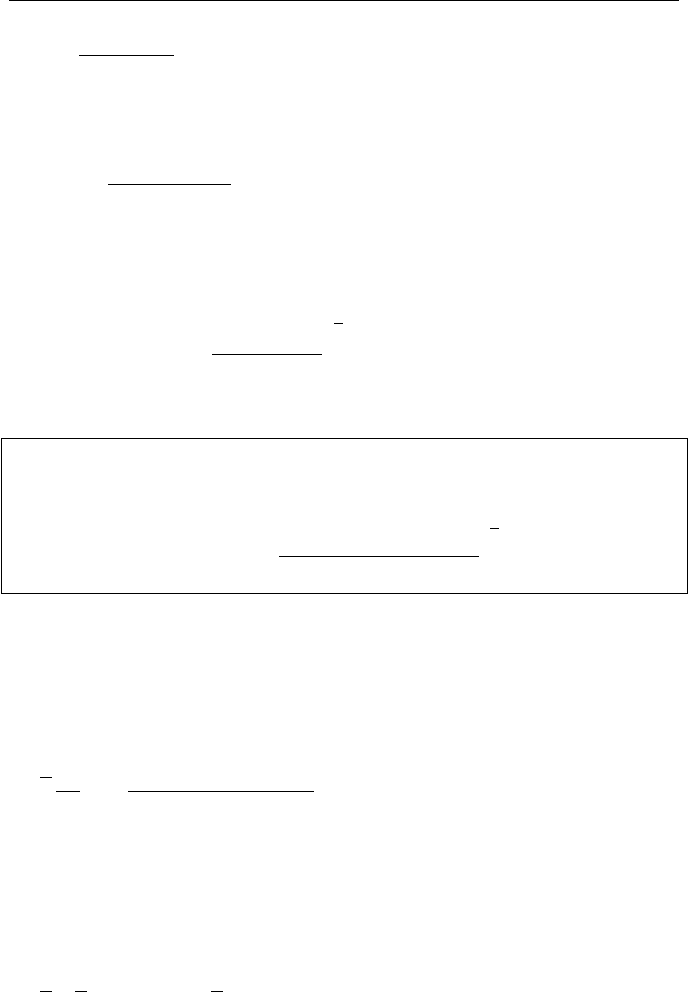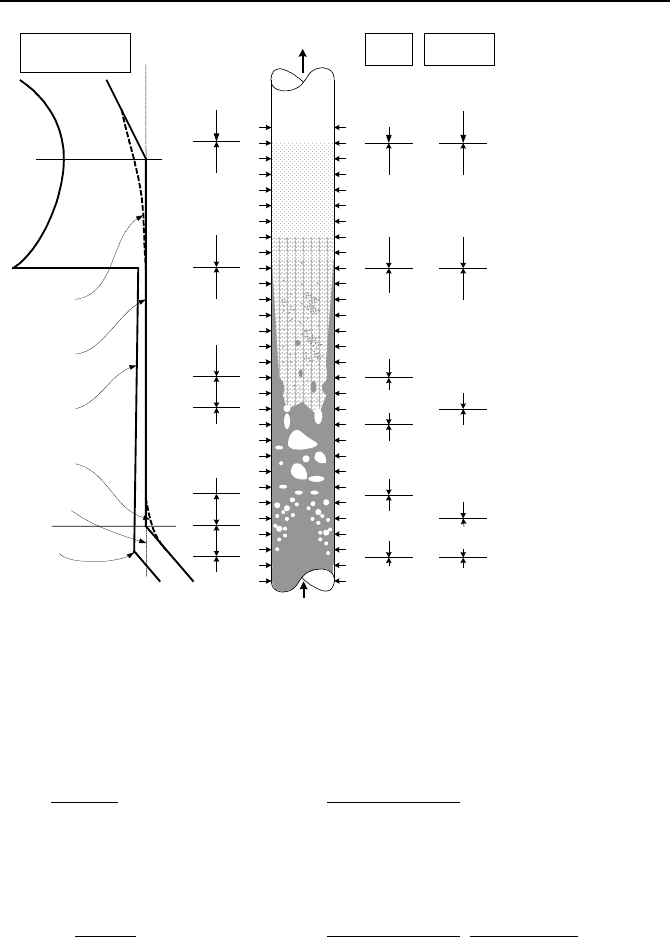Massoud M. Engineering Thermofluids: Thermodynamics, Fluid Mechanics, and Heat Transfer
Подождите немного. Документ загружается.


652 Vb. Two-Phase Flow and Heat Transfer: Boiling
Example Vb.4.1. Water is boiling in a container at atmospheric pressure. The
heated surface area is 0.1 m
2
and is made of mechanically polished stainless steel.
An electric heater is used to carefully maintain the heated surface superheat at 17
C. Find a) the required power, b) the heat transfer coefficient, and c) the rate of
evaporation from the heated surface.
Solution: From Table AIV5(SI) for saturated water and steam at T
sat
= 100 C, we
find
ρ
f
= 958 kg/m
3
,
ρ
g
= 0.595 kg/m
3
, h
fg
= 2257 kJ/kg, c
p,f
= 4.217 kJ/kg·K,
µ
f
=
0.279E-3 N·s/m
2
, Pr
f
= 1.76,
σ
= 0.0589 N/m
a) Since the surface superheat, T
s
– T
sat
= 17 C, thus T
s
= 100 + 17 = 117 C. From
Table Vb.4.1 for mechanically polished stainless steel and water, we find C
sf
=
0.0132 and n = 1. Equation Vb.4.1b yields:
3
5.0
76.122570132.0
17217.4
0589.0
)595.0958(8.9
3E22573E279.0
¸
¹
·
¨
©
§
××
×
»
¼
º
«
¬
ª
−×
××−=
′′
q
= 642 kW/m
2
The required power for boiling at the specified condition is AqQ ×
′′
=
= 642 ×
0.1 = 64.2 kW.
b) Having the surface superheat and heat flux, the related heat transfer coefficient
is found as:
8.37
17
000,642
==
−
′′
=
sats
TT
q
h
kW/m
2
·C
c) At steady state, the power delivered to saturated water is converted to the latent
heat of vaporization, Equation IIa.7.2:
0284.0
2257
2.64
===
fg
h
Q
m
kg/s = 102.4 kg/h
Comment: By using the software included on the accompanying CD-ROM, it can
be easily verified that for a specified surface and surface superheat, the heat flux
increases with increasing system pressure.
4.2. Critical Heat Flux in Pool Boiling
Kutateladze and later Zuber devised the following CHF correlation, which is only
a function of pressure:
25.0
2
)(
149.0
»
»
¼
º
«
«
¬
ª
−
=
′′
g
gf
gfgCHF
g
hq
ρ
ρρσ
ρ
Vb.4.2

4. Pool Boiling Modes 653
To avoid damage to heated surfaces, a safety factor is applied in the design of the
heating elements to maintain heat flux well below the value predicted by Equa-
tion Vb.4.2.
Example Vb.4.2. A PWR rod is operating at a linear heat generation rate of 7
kW/ft. Find the safety factor according to the pool boiling CHF.
Solution: We first find the maximum heat flux from Equation Vb.4.2.
Using properties at P = 2250 psia we find:
=
′′
CHF
q
0.149(416.4 × 6.4)[0.000335 × 32.2
2
(37.1 – 6.4)/6.4
2
] = 283.6 Btu/ft
2
·s
A typical PWR rod diameter is about 0.44 inch, thus:
Dqq
π
/'
=
′′
= 7/(3.14 × 0.44/12) = 60.8 Btu/ft
2
·s
The safety factor is 283.6/60.8 = 4.70.
4.3. Transition Pool Boiling
Transition boiling refers to the region between T
CHF
and T
MSFB
. This region is ex-
perienced in a temperature-controlled boiling process. In this region, both nucle-
ate and film boiling mechanisms coexist as the surface temperature is not high
enough for film boiling to dominate. Due to the complicated nature of the transi-
tion boiling mechanism, there is no correlation that can reliably predict the wall
heat flux. Most correlations use a weighted average value between the heat flux
corresponding to maximum heat flux (
CHF
q
′′
) and the heat flux corresponding to
the minimum stable film boiling (
MSFB
q
′′
).
4.4. Minimum Stable Film Boiling
In temperature-controlled boiling, sufficiently high wall temperature in the transi-
tion boiling mode precludes nucleate boiling and covers the surface with a film of
vapor. The temperature at which nucleation is completely ceased is the minimum
stable film boiling (MSFB) temperature. To determine the heat flux at the point of
minimum stable film boiling, we may use the definition of the Stanton number
given as:
TVc
q
TcVA
Q
hm
Q
pp
∆
′′
=
∆
=
∆
=
ρρ
))((
St
when applied to conditions where a change of phase is involved, St becomes:

654 Vb. Two-Phase Flow and Heat Transfer: Boiling
'
min
min
St
fgg
hV
q
ρ
′′
=
where V
min
in the denominator is given by:
()
()
2/1
min
¸
¸
¹
·
¨
¨
©
§
+
−
=
vl
cvl
Lg
V
ρρ
ρρ
where L
c
is a characteristic length given by Equation Vb.1.1. For large horizontal
surfaces, Berenson suggested St = 0.09. Using Berenson’s value and substituting
for the characteristic length, the minimum heat flux is found as:
()
()
4
1
2
09.0
»
»
¼
º
«
«
¬
ª
−
−
=
′′
vl
vl
fgvMSFB
g
hq
ρρ
ρρσ
ρ
Vb.4.3
Example Vb.4.3. Find the heat flux at the Leidenfrost point. Use P = 1 atm.
Solution: Using the saturated water properties at 100 C, Equation Vb.4.3 gives
()
()
()
=
»
»
¼
º
«
«
¬
ª
+
−×
××=
′′
4
1
2
59.0958
59.095881.9059.0
3E225759.009.0
MSFB
q
19 kW/m
2
4.5. Film Pool Boiling
The resemblance of the vapor film in the film boiling heat transfer to the conden-
sate film in the laminar film condensation heat transfer prompted Bromely to sug-
gest a correlation similar to Equation Va.2.6 for boiling on cylinders and spheres:
4/1
3
)(
)(
»
»
¼
º
«
«
¬
ª
−
′
−
=
satsvv
fgvvf
v
TTk
Dhg
C
k
D
h
µ
ρρρ
Vb.4.4
In Equation Vb.4.4, C = 0.62 for horizontal cylinders and 0.67 for spheres. Also
=
′
fg
h h
fg
+ 0.4c
p,v
(T
s
– T
sat
). Vapor properties are evaluated at T
film
= (T
s
+ T
sat
)/2.
Since the contribution of radiation heat transfer becomes noticeable as the surface
temperature approaches and exceeds 300 C, Bromley recommends the follow-
ing h:
radiationconvection
hhh 75.0+= Vb.4.5
where in Equation Vb.4.5, the heat transfer coefficient due to radiation is given as:

4. Pool Boiling Modes 655
radiation
h = )/()(
44
satssats
TTTT −−
εσ
In this relation
ε
and
σ
are surface emissivity and the Stefan-Boltzmann constant,
respectively.
Example Vb.4.4. A horizontal cylinder, having a surface temperature of 300 C is
submerged in saturated water at 100 C. Estimate the surface heat flux. Cylinder
diameter is 4 cm and
ε
= 0.85.
Solution: Using saturation properties at 100 C we find
ρ
f
= 958 kg/m
3
, and h
fg
=
2257 kJ/kg. For superheated properties at 1 atm and a film temperature of 200 C:
ρ
v
= 0.46 kg/cm
3
, c
p,v
= 1.98 kJ/kg·K,
µ
v
= 0.16E-4 Pa·s, and k
v
= 0.033 W/m·K.
=
′
fg
h h
fg
+ 0.4c
p,v
∆T
= 2257 + 0.4 × 1.98 × 200 = 2415 kJ/kg.
Using Equation Vb.4.4:
convection
h =
4/1
3
)100300(033.0)4E16.0(
04.03E241546.0)46.0958(81.9
04.0
033.0
62.0
»
¼
º
«
¬
ª
−××−
×××−×
= 144 W/m
2
·K
radiation
h = 0.85 × 5.67E-8 (573
4
– 373
4
)/(573 – 373) = 21 W/m
2
·K
h =
convection
h + 0.75
radiation
h = 144 + 0.75 × 21 = 160 W/m
2
·K
32200160 =×=∆=
′′
Thq
kW/m
2
.
For film boiling on horizontal plates, Berenson’s correlation is given as:
425.0/Nu ==
vv
kh
δ
Vb.4.6
where
δ
v
, an average vapor film thickness, used in the Nu number is given by:
4/1
2
Ja4.01
Ja
Pr
1
»
»
¼
º
«
«
¬
ª
+−
=
v
v
vvf
vcv
v
g
Lv
ρρ
ρ
δ
Vb.4.7
In Equation Vb.4.7, L
c
is the characteristic length as given in Equation Vb.1.1 and
vapor properties are evaluated at T
film
.

656 Vb. Two-Phase Flow and Heat Transfer: Boiling
Example Vb.4.5. Find the convection heat flux for film boiling of water at 1 at-
mosphere on top of a horizontal plate with T
s
= 900 K.
Solution: Film temperature is T
film
= 0.5(373 + 900) = 636.5 K. At atmospheric
conditions,
ρ
f
= 958 kg/m
3
, h
fg
= 2.257E6 J/kg and
σ
= 0.06 N/m.
For superheated steam at 636.5 K:
c
pv
= 2048 J/kg·K, v
v
= 66.4E-6 m
2
/s,
ρ
v
= 0.345 kg/m
3
, and k
v
= 0.05 W/m·K
()
6E257.2/3739002048/Ja
,
−×=∆=
fg
v
pv
hTc = 0.48
()
2/1
/
ρσ
∆= gL
c
= [0.06/(9.81 × 958)]
0.5
= 2.53E-3 m
=
×+−
−×−
=
25.0
2
]
48.04.01
48.0
93.0
1
349.0958
0.345
9.81
3E53.2)6E4.66(
[
g
δ
0.115 mm
h
convection
= (k
v
/
δ
v
)Nu = (0.05/0.115E-3) × 0.425 = 185 W/m
2
·K
Convection
q
′′
= h
convection
∆T = 185 × (900 – 373) = 98 kW/m
2
.
4.6. Minimum Stable Film Boiling Temperature
Temperature at the MSFB point may be found by using Newton’s law of cooling
and substituting for heat flux from Equation Vb.4.3 and for heat transfer coeffi-
cient from Equation Vb.4.4, for horizontal cylinders and spheres, or from Equa-
tion Vb.4.5 for horizontal plates. For horizontal cylinders and sphere we find:
()
()
()
2/1
3/1
2
126.0
»
¼
º
«
¬
ª
−
»
»
¼
º
«
«
¬
ª
+
−
′
=−
vl
vl
vvl
v
fgv
satMSFB
g
g
k
h
TT
ρρ
σ
ρρ
µρρ
ρ
Vb.4.8
where the vapor physical properties are developed at the film temperature.
Example Vb.4.6. For heat treatment, a long steel cylindrical rod is immersed
horizontally in a pool of water at atmospheric pressure. The rod diameter is 4 cm.
Find T
MSFB
and the heat flux when surface is at 400 C. Use
ε
= 0.66.
Solution: For sufficiently hot surface, the entire boiling curve is traversed when
the rod is immersed. If the initial heat transfer regime is film boiling, surface
temperature begins to drop by both convection and radiation mechanisms until the
MSFB point is reached. When T
rod
drops below T
MSFB
, partial nucleation takes
place in the transition boiling region, increasing heat flux. This trend continues
until the maximum heat flux is reached, further cooling the rod. As the rod gets
colder, the required superheat for nucleation diminishes and heat begins to transfer
by single-phase natural convection. We then start by calculating T
MSFB
:
To find T
MSFB
, we need T
film
. We assume T
s
= 200 C and use Equation Vb.4.8:

4. Pool Boiling Modes 657
()
()
()
2/1
3/1
2
52.095781.9
06.0
52.0958
)4E14.0(52.095881.9
029.0
3E233652.0
126.0
»
¼
º
«
¬
ª
−
»
»
¼
º
«
«
¬
ª
+
−×−×
=∆
MSFB
T
We find T
MSFB
= 170 C. Next, we assume T
s
= 180 C and find T
MSFB
= 173 C. We
continue iteration until the answer converges to T
MSFB
≈ 185 C. Thus initially
heat transfer regime is film boiling. We find the initial heat flux from Equa-
tion Vb.4.4:
()
()()
=
»
¼
º
«
¬
ª
−××−
×××−
=
25.0
3
100400038.04E18.0
04.03E249642.042.095881.9
04.0
038.0
62.0h
140 W/m
2
·K
()
()
244
44
kW/m473736738E67.566.075.0300140
75.0
=−×−××+×=
−+∆=
′′
fs
TTThq
εσ
4.7. Factors Affecting Pool Boiling
The pool boiling mode is influenced by several factors including gravity, pressure,
surface roughness, aging, and the presence of noncondensable gases.
Effect of gravity. Among all the boiling modes, gravity primarily affects
nucleation. In zero gravity, there is no nucleation as a large bubble would sur-
round the heated surface. As gravity increases, heat transfer becomes more ef-
ficient due to enhanced free convection. If boiling is used as a cooling mechanism
in the rotating machinery and in space vehicles, changes in gravity become a
design consideration.
Effect of pressure. The rate of heat transfer in nucleate boiling is increased
with pressure. This is apparent from the Clausius-Clapeyron equation. By treat-
ing vapor as an ideal gas, it can be shown that the degree of superheat is inversely
proportional to pressure. Hence, at high pressures less ∆T
sl
is needed for the same
number of nucleation sites to become active. For example, if ∆T
sl
= 12 F, when
pressure is increased by about 6.5 times (from 383 psia to 2465 psia) heat flux in-
creases by 12.5 times (from 8E4 Btu/ft
2
·h to 1E6 Btu/ft
2
·h).
Effect of surface roughness was extensively studied by Berenson who demon-
strated that the effect of surface roughness on heat transfer depends on the boiling
mode. Berenson showed that pre-CHF is affected strongly, transition boiling
moderately, and film boiling is not affected by surface conditions.
Effect of aging. Aging adversely affects boiling heat transfer due to surface
oxidation. The layer of oxide increases thermal resistance, but it also increases the
population of cavities.
Effect of noncondensable gases on boiling is to enhance surface heat flux.
The dissolved gases in the liquid are released near the heated surface, agitating the
liquid and increasing mixing.

658 Vb. Two-Phase Flow and Heat Transfer: Boiling
5. Flow Boiling Modes
Flow boiling is associated with the flow of liquids into a heated conduit. As
shown in Figure Vb.5.1, flow at the entrance of the conduit is single-phase liquid
and heat transfer from the heated wall is found from forced convection correlation
(A). As the liquid travels in the conduit, the layer adjacent to the heated surface
enters the surface cavities. If sufficient superheat is available, the site becomes
active. Bubbles generated in such sites would migrate toward the bulk liquid,
which is still subcooled (B). This constitutes the subcooled flow boiling regime.
Expectedly, heat transfer in this regime is due to both subcooled boiling as dis-
cussed in Section 4 for subcooled pool boiling and forced convection for single-
phase liquid. Collapse of a bubble increases liquid energy, more bubbles are pro-
duced, resulting in the related flow regime being referred to as bubbly flow (C).
Wall temperature remains constant the moment subcooled boiling is initiated. On
the other hand, liquid temperature keeps increasing until the bulk liquid eventually
reaches saturation. Hence, the related heat transfer regime is called saturated nu-
cleate boiling (D).
As flow travels further in the conduit, the nucleation process becomes so effec-
tive that bubble population grows to a point that bubbles eventually begin to coa-
lesce to form a slug. The related flow regime is known as slug flow (D). When
slugs coalesce, a central vapor core is formed. The flow pattern where the vapor
core is surrounded by a film of liquid is known as annular flow (E). The related
heat transfer regime remains saturated nucleate boiling. However, the process of
nucleation is soon replaced by evaporation (E and F). In this regime, surface heat
is transferred to the liquid film by forced convection, which is then transferred to
the liquid-vapor interface where evaporation takes place. The corresponding heat
transfer regime is often called forced convection vaporization. With continuous
evaporation, the liquid film eventually dries out. Following dryout, surface tem-
perature jumps to elevated values due to the lack of effective liquid cooling.
There is a slight drop in the surface temperature due to the lingering droplets,
which would randomly touch the surface (G). These drops soon vaporize, result-
ing in a continuous rise in surface temperature due to heat transfer to single-phase
vapor.
5.1. Subcooled Flow Boiling
There are several correrlations for the calculation of the heat transfer coefficient in
subcooled flow boiling (Delhaye, Ginoux, and Problem 9). However, the most
widely used correlation, which is applied to both subcooled and saturation regions,
is the Chen correlation as discussed next.
5.2. Saturated Flow Boiling
The Chen correlation accounts for both macro-convection due to flow and micro-
convection due to boiling. As such, the Chen correlation is applicable over the en-

5. Flow Boiling Modes 659
Single-
Phase
Liquid
Bubbly
FLow
Slug
Flow
Drop
Flow
Single-
Phase
Vapor
Convective Heat
Transfer To Liquid
Forced
Convection
Heat
Transfer
Through
Liquid Film
Liquid
Deficient
Region
Saturated
Nucleate
Boiling
Subcooled
Boiling
Convective
Heat Transfer
To Vapor
Heat Transfer
Regimes
Annular
Flow
Annular
Flow
with
Entrainment
Flow
Patterns
Fluid And Surface
Temperatures
Fluid
Temperature
Surface
Temperature
Liquid Bulk
Temperature
Saturation
Temperature
Vapor Bulk
Temperature
x = 0
x = 1
A
B
C
D
E
F
G
H
Incipient Boiling
Figure Vb.5.1. Flow and heat transfer regimes in a sufficiently long heated conduit (Col-
lier)
tire range of subcooled boiling, saturation boiling, and forced convection vapori-
zation regions. The Chen correlation in SI units is given as:
()
0.79 0.45 0.49
0.8
,
0.4 0.24 0.75
0.29 0.5 0.24 0.24
0.023
Re Pr 0.00122
ffpff
SI f f sat
h
ffgg
kkc
hF TPS
Dh
ρ
µσ ρ
=+ ∆∆ Vb.5.1a
substituting for
∆P from the Clapeyron equation, the Chen correlation in British
units becomes:
()
ST
Tv
h
h
gck
F
D
k
h
sat
satfg
fg
gfgf
cffpf
ff
h
f
BU
99.0
75.0
24.024.05.029.0
25.049.045.0
,
79.0
4.0
8.0
)460(
778
00122.0PrRe
023.0
∆
»
»
¼
º
«
«
¬
ª
+
+=
ρσµ
ρ
Vb.5.1b
where Re
f
= G(1 – x)D
h
/
µ
f
and the conversion factor g
c
is defined in Chapter IIa.
The first term in Equation Vb.5.1 applies to subcooled boiling and follows the Dit-
tus–Boelter correlation with a modification factor F, which accounts for the en-

660 Vb. Two-Phase Flow and Heat Transfer: Boiling
hanced flow and turbulence due to the presence of vapor. The second term in
Equation Vb.5.1 applies to nucleation and follows the Forster-Zuber analysis,
modified with the suppression factor S. The modification factors F is given in
terms of X
M
:
1.05.0
9.0
1
¸
¸
¹
·
¨
¨
©
§
¸
¸
¹
·
¨
¨
©
§
¸
¹
·
¨
©
§
−
=
f
g
g
f
M
x
x
X
µ
µ
ρ
ρ
so that for the F factor,
[]
736.0
213.035.2
M
XF += , which applies if X
M
> 0.1.
Otherwise, F = 1. Also, the S factor is given as
117.1
]Re)653.2(1[
−
−+= ES
where
25.1
ReRe F
f
= = [G(1 – x)D
h
/
µ
f
]F
1.25
.
Example Vb.5.1. Water flows in a vertical 1 in heated tube at a rate of 0.5 lbm/s.
System pressure is 1000 psia. Find heat flux at a point where steam quality is
25% and surface superheat is ∆T
sat
= T
s
– T
sat
= 8 F.
Solution: First, we find properties at 1000 psia:
ρ
f
= 46.33 lbm/ft
3
,
µ
f
= 0.229 lbm/ft·h, c
p,f
= 1.286 Btu/lbm, h
fg
= 650.5 Btu/lbm,
σ
= 0.0012 lbf/ft
ρ
g
= 2.23 lbm/ft
3
,
µ
g
= 0.046 lbm/ft·h, k
f
= 0.33 Btu/ft·h·F, v
fg
= 0.43 ft
3
/lbm,
Pr
f
= 0.899, T
sat
= 544.33 F
ρ
f
= 46.33 lbm/ft
3
,
ρ
g
= 2.23 lbm/ft
3
, h
fg
= 650.5 Btu/lbm, c
p,f
= 1.286 Btu/lbm,
µ
f
= 0.229 lbm/ft·h,
µ
g
= 0.046 lbm/ft·h, k
f
= 0.33 Btu/ft·h·F, Pr
f
= 0.899,
σ
= 0.0012 lbf/ft, v
fg
= 0.43 ft
3
/lbm and T
sat
= 544.33 F.
We now find X
M
, F, S, and finally h. First X
M
is found from:
1.05.09.0
23.0
046.0
23.2
33.46
75.0
25.0
¸
¹
·
¨
©
§
¸
¹
·
¨
©
§
¸
¹
·
¨
©
§
=
M
X = 1.44
The F factor becomes
[]
736.0
213.035.2
M
XF += = 2.35(0.213 + 1.44)
0.736
= 3.41
Diameter and flow area are: d = 1/12 = 0.0833 ft and A =
π
d
2
/4 = 3.14 × 0.0833
2
/4
= 5.45E-3 ft
2
G = Am /
= 0.5/5.45E-3 = 92 lbm/ft
2
·s
To find S, we need to find:
Re
f
= (0.5 × 3600)(1 – 0.25) × 0.0833/(0.229 × 5.45E-3) = 90,072
Re = Re
f
× F
1.25
= 90,072 × 3.41
1.25
= 417,381
S = (1 + 2.53E-6 × 417,381
1.17
)
–1
= 0.095
The convection heat transfer coefficient (h
c
) from Equation Vb.5.1b is:
h
c
= 0.023(0.33/0.0833)(90,072)
0.8
× 0.899
0.4
× 3.55 = 2737 Btu/ft
2
·h·F.
The nucleation heat transfer coefficient (h
b
) from Equation Vb.5.1b is:

5. Flow Boiling Modes 661
Numerator: 0.00122
× 0.33
.79
× 1.286
.45
× 46.33
.49
× (32.2 × 3600
2
)
.25
= 0.533
Denominator: 0.229
.29
× 0.0012
.5
× 650.5
.24
× 2.23
.24
= 0.13
Bracket: [778 × 650.5/(0.43 × 1004.33)]
.75
= 200.3
h
n
= (0.533/0.13) × 200.3 × 8
.99
× 0.095 = 611 Btu/ft
2
·h·F
h = h
c
+ h
n
= 2737 + 611 = 3348 Btu/ft
2
·h·F
786,2683348 =×=∆=
′′
Thq
Btu/ft
2
·h = 84 kW/m
2
.
Example Vb.5.2. Water at a rate of 1200 kg/h flows in a tube having an inside
diameter of 30 mm. Pressure is 10 MPa. Find the heat transfer coefficient and the
surface heat flux at a location where surface superheat is 10 C and quality is 15%.
Solution: First, we find properties at 10 MPa:
ρ
f
= 688.7 kg/m
3
,
µ
f
= 0.86E-4 N·s/m
2
, h
fg
= 1320 kJ/kg, c
p,f
= 6.159 kJ/kg·K,
σ
= 0.012 N/m,
ρ
g
= 55.14 kg/m
3
,
µ
g
= 0.21E-4 N·s/m
2
, v
fg
= 0.016 m
3
/kg, k
f
= 0.522 W/m·K,
Pr
f
= 1.02, T
sat
= 310.88 C.
Similar to Example Vb.5.1, we find X
M
, F and S factors, and h
c
and h
n
:
Find X
M
from: X
M
= (0.15/0.85)
0.9
(688.7/55.14)
0.5
(0.21E-4/0.86E-4)
0.1
= 0.644
The F factor becomes:
[]
736.0
213.035.2
M
XF += = 2.35(0.213 + 0.644)
0.736
= 2.1
d = 0.03 m, A =
π
d
2
/4 = 3.14 × 0.03
2
/4 = 7.068E-4 m
2
, and G = 1200/7.068E-4 =
471.6 kg/m
2
·s
To find S, Re
f
= G(1 – x)D
h
/
µ
f
= 471.6 × (1 – 0.15) × 0.03/ 0.86E-4= 139,835
Re = Re
f
× F
1.25
= 139,835 × 2.1
1.25
= 353,500 and
S = (1 + 2.53E-6 × 353,500
1.17
)
–1
= 0.11
The convection heat transfer coefficient (h
c
) from Equation Vb.5.1a is:
h
c
= 0.023(0.522/0.03)(139,835)
0.8
× 1.02
0.4
× 2.1 = 11,077 W/m
2
·K
The nucleation heat transfer coefficient (h
n
) from Equation Vb.5.1a is:
Numerator: 0.00122 × 0.522
.79
× (6.159E3)
.45
× 688.7
.49
= 0.91
Denominator: (0.86E-4)
.29
× 0.012
.5
× (1320E3)
.24
× 55.14
.24
= 0.559
∆T
sat
= 10 C, T
surface
= T
sat
+ 10 = 320.88 C
∆P = P
sat
(320.88) – P
sat
(310.88) = 11.42 – 10 = 1.42E6 Pa
h
n
= (0.91/0.559) × (1.42E6)
0.75
(10)
0.24
× 0.11 = 12800 W/m·K
h = h
c
+ h
n
= 11,077 + 12,800 = 23,878 W/m·K
7.23810878,23 =×=∆=
′′
Thq
kW/m
2
.
